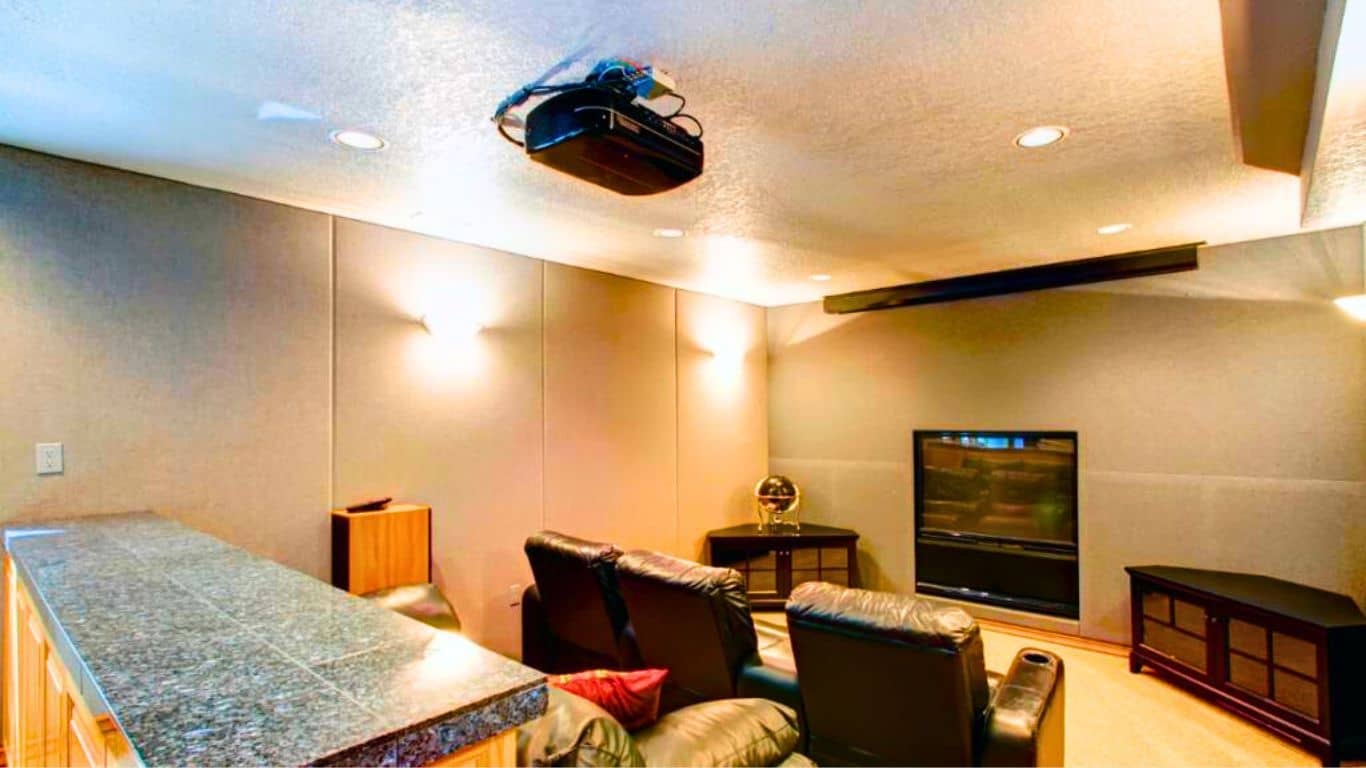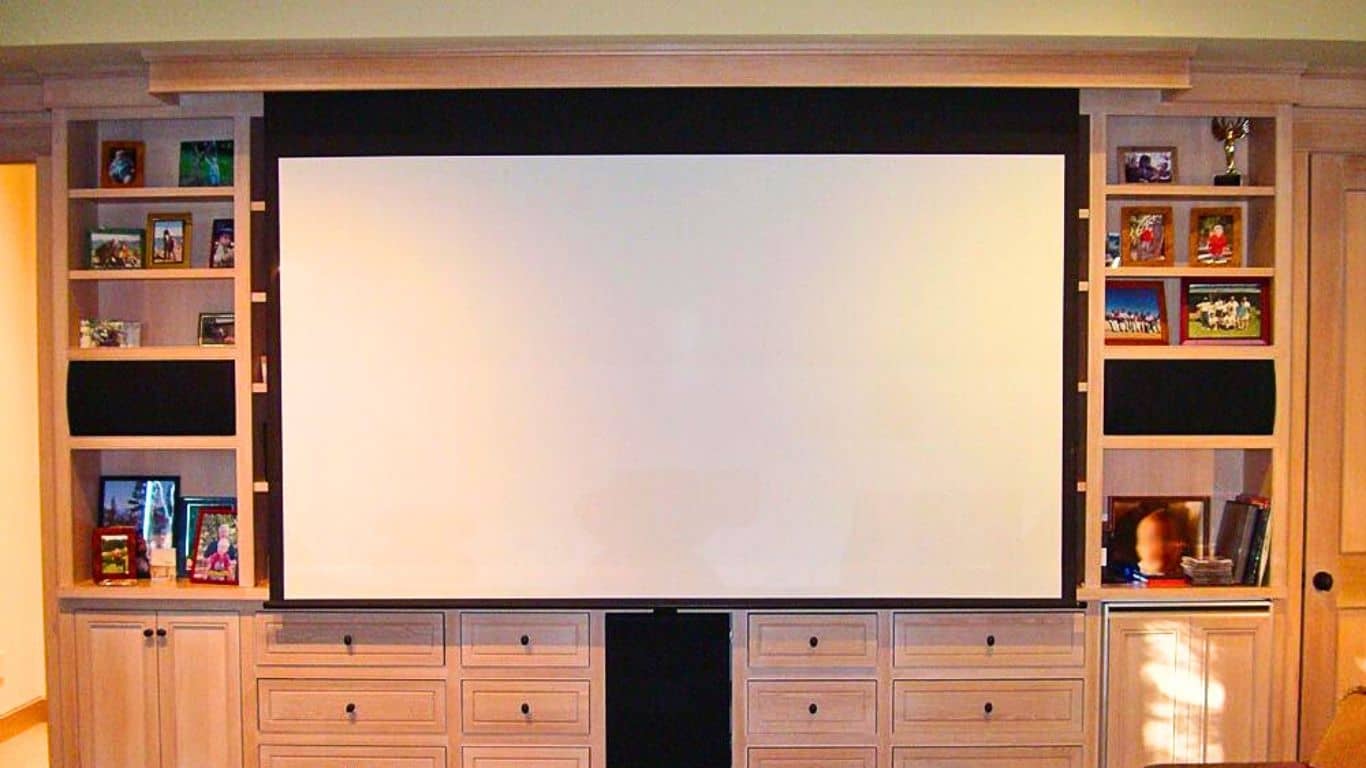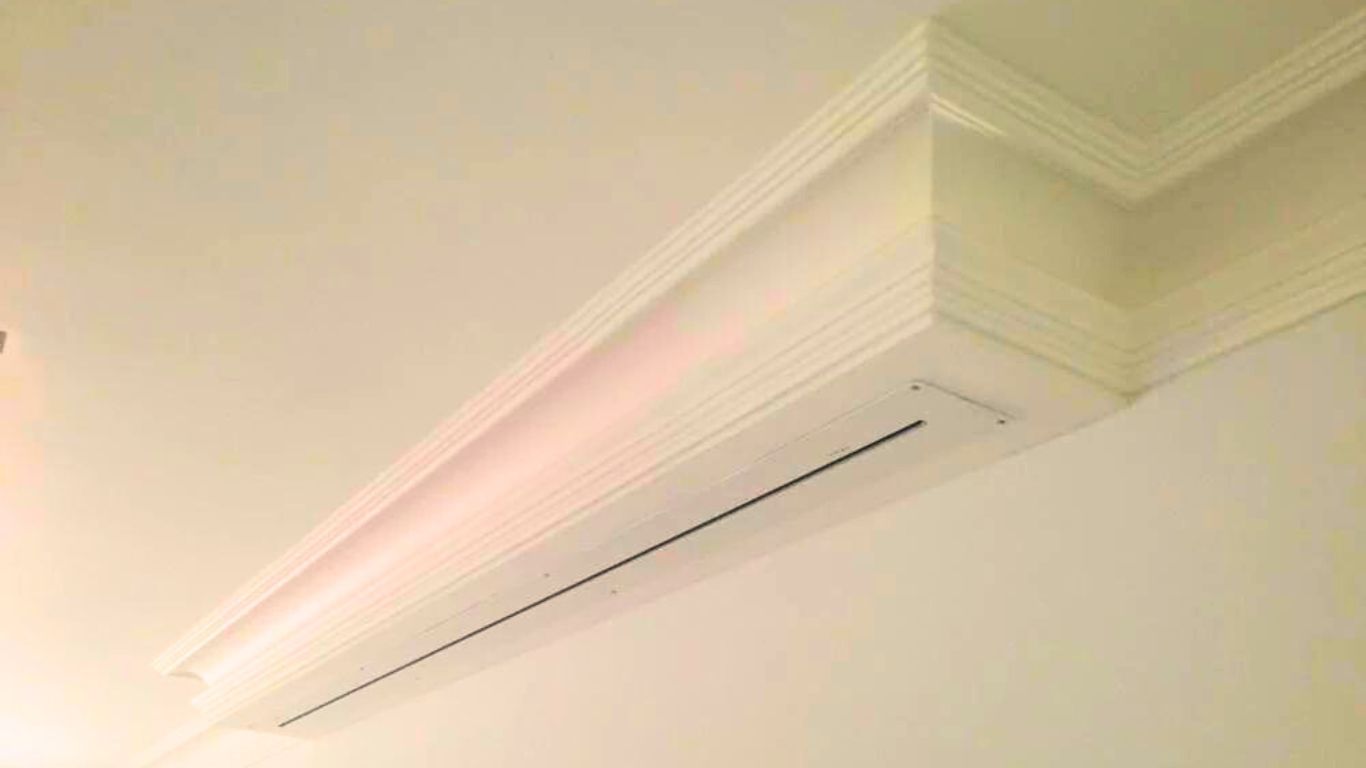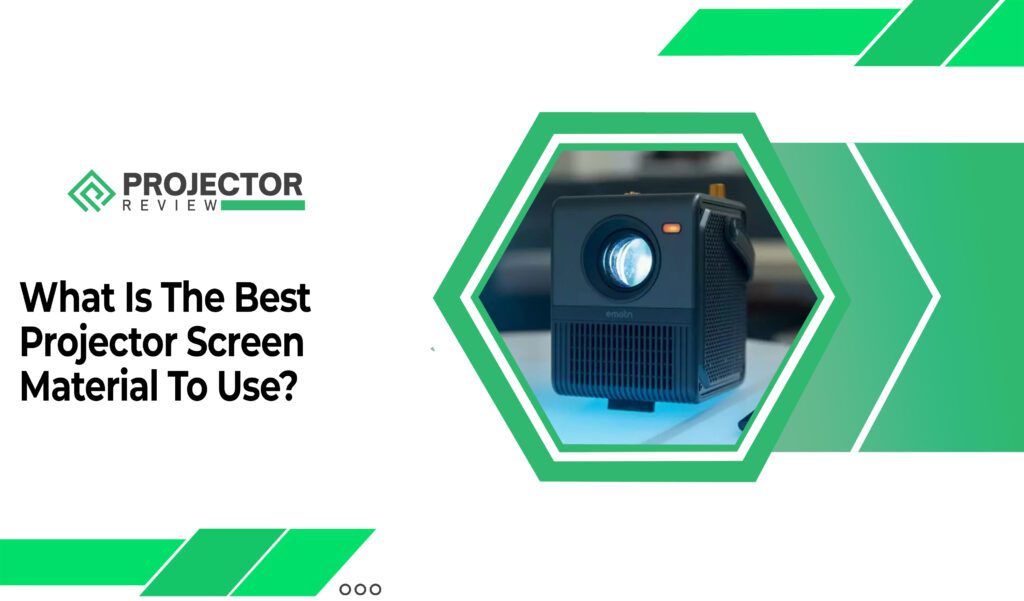Are you tired of your projector screen taking up valuable space and disrupting the aesthetics of your room?
Well, you’re in luck! In this article, we’re about to unveil some clever and creative ways to hide that projector screen without compromising the quality of your movie nights or presentations. You must want to know if are projectors better for your eyes, so they are safe with good materials.
Imagine having a sleek, clutter-free living room where your projector screen seamlessly blends into the decor or a conference room where the screen is hidden until you’re ready to impress your audience.
We’ll be sharing hidden projector screen ideas and tips from experts who won’t break the bank or require advanced DIY skills.
Whether you’re a movie enthusiast, a professional presenter, or simply someone looking to declutter their space, you’ll find practical solutions to concealed projector screens effectively.
To get more valuable and satisfying tips, keep reading!
Why you should hide a projector screen?
Hiding a projector screen serves several practical and aesthetic purposes:
Aesthetics
DLP vs. LCD Projector screens, when not in use, can be quite conspicuous and disrupt the overall aesthetics of a room. Hiding the screen allows you to maintain a cleaner, more visually pleasing living or workspace.
Space Optimization
In smaller rooms or spaces with limited wall real estate, a permanently visible projector screen can make a room feel cramped. Concealing it when not in use frees up valuable space for other activities and decor.


Versatility
Concealing the screen allows you to use the same space for multiple purposes. For example, a living room can easily transform from a cozy entertainment area to a functional gathering space.
Enhanced Viewing Experience
Some setups involve hiding the screen behind a motorized cover that can enhance the surprise and excitement of movie nights or presentations when the screen is revealed with a touch of a button.
Privacy
In office environments, hiding the projector screen when not in use can prevent unintentional distractions during meetings or presentations, maintaining privacy and focus.
How to hide the screen on a projector Mac?
Hiding the screen on a Mac while using a projector can be useful during presentations or when you want to keep your content private. Here’s how you can do it:
Using Display Preferences
To hide your Mac’s screen while using a projector or HDTV, you can adjust the display settings in your System Preferences like ANSI Lumens vs. Lumens.
- Step 1: Connect your Mac to the projector using the appropriate cable (HDMI, VGA, or Thunderbolt).
- Step 2: Click on the Apple logo in the top-left corner of your screen.
- Step 3: Select “System Preferences” from the dropdown menu.
- Step 4: In the System Preferences window, click on “Displays.”
- Step 5: You will see two display icons, one representing your Mac’s screen and the other for the projector. Click on the icon for your Mac’s screen.
- Step 6: In the arrangement tab, uncheck the box that says “Mirror Displays.” This will make your Mac’s screen go blank while the projector displays the content.
- Step 7: You can also choose to adjust the resolution and arrangement settings to ensure your content displays correctly on the projector.


Third-Party Applications
There are third-party applications available, like “KeyCastr” or “BackgroundMusic,” that can help you manage screen visibility during presentations. These applications provide more control over screen visibility and can be customized to your preferences.
Tips to Concealed Projector Screen
Here are several methods to keep your projector screen hidden in the wall with safety to give your bedrooms, living rooms, and other indoor places more area with a new look and techniques of professionals, these following must be helpful and easy to understand;
1. DIY Hidden Projector Screen
Creating a hidden projector screen as a do-it-yourself (DIY) project can be both cost-effective and customizable to your space. You have to know how to hang a projector screen. Here’s a professional guide to this approach:
- Materials and Tools
Start by gathering the necessary materials, which typically include a motorized or retractable projector screen, mounting brackets, a sturdy ceiling mount, and appropriate electrical wiring tools.
- Location Selection
Carefully choose the location on your ceiling where you want to install the projector screen. Ensure it’s centered and at the right height for optimal viewing.
- Installation Steps
Follow the manufacturer’s instructions for assembling and mounting the screen. Securely attach the brackets to the ceiling, ensuring they are level and well-anchored. Connect the electrical wiring to enable motorized or retractable functionality. Be careful about how many watts a projector uses.
- Integration
Consider integrating the projector screen with a home automation system or remote control for seamless operation behind a bookshelf. This allows you to hide or reveal the screen with ease, creating a sophisticated, tech-savvy setup.
- Finishing Touches
Conceal the screen when not in use with a decorative valance or a false ceiling. This provides a polished, finished appearance to your hidden projector screen.
2. Motorized Ceiling Drop-Down Screen
Another expert method to hide a projector screen involves a motorized ceiling drop-down screen. This solution offers a clean and modern aesthetic:
- Professional Installation
Consult with a home theater specialist or professional installer to select the appropriate DC motor ceiling drop-down screen. They will assess your space, determine the best location, and handle the installation.
- Customization
Opt for a screen that can be concealed within a ceiling recess, so it’s completely hidden when not in use. This provides an unobstructed view of your room when the screen is not in operation.
- Remote Control
Ensure that the screen comes with a bearing remote control or can be integrated into your home automation system and do projectors have blue light. This makes it easy to lower or raise the screen as needed.
3. Projector Screen in a False Ceiling
This method involves integrating the projector screen into a false or suspended ceiling for a truly concealed appearance:


- Architectural Planning
During the construction or renovation phase, work with an architect or contractor to design a false ceiling that accommodates a concealed projector screen. The screen can be hidden within a dedicated compartment or alcove.
- Custom Engineering
Engage professionals who specialize in ceiling-hidden projector screens to ensure a perfect fit and seamless integration. These screens often come with advanced features like automatic masking systems for various aspect ratios.
- Motorized Functionality
Integrate motorized mechanisms into the false ceiling design to smoothly lower or raise the screen. Control can be managed via remote, wall switch, or automation system.
4. Ceiling Recessed Installation
This method involves recessing the projector screen into the ceiling, providing a seamless and hidden appearance. You must know how projectors work, before hiding them. Here’s how it’s done:
- Professional Installation
Ceiling recessed installations are typically performed by professional AV installers due to their complexity.
- Cassette Housing
A cassette housing is used to enclose the screen when not in use. It is mounted within the ceiling, leaving only a discreet slot visible.
- Screen Integration
The projector screen is integrated into the cassette housing, and a motorized mechanism allows it to descend when needed.
- Remote Control
Most ceiling-recessed screens come with remote controls for easy operation. Advanced models can be integrated with home automation systems.
5. Hidden Projector Screen Shelf
It combines functionality with aesthetics, allowing you to maintain a clean and uncluttered living or workspace while still enjoying the benefits of a projector screen for presentations, movie nights, or other purposes. Here’s how a hidden projector screen shelf works:
- Design and Installation
The hidden projector screen shelf is designed as a discreet storage or display bookcase that can be mounted on a wall or positioned within a custom-built cabinet or alcove.
This shelf is designed to be wide and deep enough to house the rolled-up or folded projector screen when it’s not in use.
- Concealed Storage
When the projector screen is not in use, it is neatly rolled up or folded and stored on the hidden shelf.
The shelf is typically designed with a cover or door that can be closed to completely conceal the projector screen from view. This cover can match the room’s decor to create a seamless and unobtrusive ceiling conclusion.
- Integration with AV Systems
To enhance convenience, some hidden projector screen shelf setups can be integrated with your audiovisual (AV) system or smart home technology. This allows you to control the screen’s deployment and retraction using a remote control, smartphone app, or voice commands.
- Customization
Hidden projector screen shelves can be customized to match the style and design of your room. You can choose the type of finish, color, and materials that best complement your decor. Its care decides how long projectors last.
How to Hide a Projector Screen – FAQs
Conclusion
This article offers valuable insights into the world of projectors and how to install a projector screen in your home as a hidden projector screen. Drawing from expert knowledge and experiences, it provides practical solutions to common questions, from concealing fixed projector screens to optimizing short-throw projector setups.
Experts’ guidance has shed light on the importance of Epson aesthetics, space optimization, and innovative integration methods. I can attest to the positive impact they can have on both the functionality and aesthetics of a room.
By concealing projectors and screens effectively, you can transform your living space into a versatile, clutter-free environment, enhancing your overall living experience by knowing what is contrast ratio in a projector is. These insights empower you to create a seamless blend of technology and design, ensuring your home is both stylish and functional.

